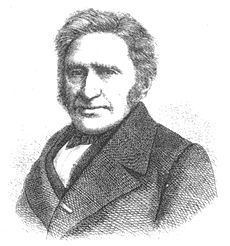Name Ludwig Reichenbach Role Botanist | ||
 | ||
Parents Johann Friedrich Jacob Reichenbach Children Heinrich Gustav Reichenbach Books Flora Germanica Excursoria | ||
Heinrich Gottlieb Ludwig Reichenbach (January 8, 1793 – March 17, 1879) was a German botanist and ornithologist. It was he who first requested Leopold Blaschka to make a set of glass marine invertebrate models for scientific education and museum showcasing, the successful commission giving rise to the creation of the Blaschkas' Glass sea creatures and, subsequently and indirectly, the more famous Glass Flowers.
Contents

Early life
Born in Leipzig and the son of Johann Friedrich Jakob Reichenbach (the author in 1818 of the first Greek-German dictionary) Reichenbach studied medicine and natural science at the University of Leipzig in 1810 and, eight years later in 1818, he the now Professor became an instructor before, in 1820, he was appointed the director of the Dresden natural history museum and a professor at the Surgical-Medical Academy in Dresden, where he remained for many years.
Glass sea creatures
Director of the natural history museum in Dresden, Professor Reichenbach was faced with an annoying yet seemingly unsolvable problem in regards to showing marine life. Land-based flora and fauna was not an issue, for it was a relatively simple matter to exhibit mounted and stuffed creatures such as gorillas and elephants, there lifelike poses attracting and exciting the museums visitors. Invertebrates, however, and by their very nature, posed a problem. In the 19th century the only practiced method of showcasing them was to take a live specimen and place it in a sealed jar of alcohol. This of course killed it but, more importantly, time and their lack of hard parts eventually rendered them into little more than colorless floating blobs of jelly. Neither pretty nor a terribly effective teaching tool, Prof. Reichenbach wanted something more, specifically 3D colored models of marine invertebrates that were both lifelike and able to stand the test of time. And, per remarkably coincidence, in 1863 "saw an exhibition of highly detailed, realistic glass flowers created by a Bohemian Lampworker named Leopold Blaschka at an exhibition hosted by Prince Camille de Rohan;" and it was the Prince who first introduced Reichenbach to Leopold Blaschka.
Enchanted by the botanical models and positive that Leopold held the key to ending his own showcasing issue, in 1863 Reichenbach convinced and commissioned Leopold to produce twelve model sea anemones. These marine models, hailed as "an artistic marvel in the field of science and a scientific marvel in the field of art," were exactly what Prof. Reichenbach needed and, at last, provided an outlet for the wonder Leopold had felt all those years ago when observing the phosphorescent ocean life. The key fact, though, was that these glass marine models were, as would soon be acknowledged, "perfectly true to nature," and as such represented an extraordinary opportunity both for the scientific community and the Blaschkas themselves. Knowing this and thrilled with his newly acquired set of glass sea creatures, Reichenbach advised Leopold to drop his current and generations long family business of glass fancy goods and the like in favor of selling glass marine invertebrates to museums, aquaria, universities, and private collectors. Advice which would prove wise and fateful both economically and scientifically, for Leopold did as the Dresden natural history museum director suggested. A decision which swiftly sparked the Blaschkas' highly lucrative mail-order business of selling this Glass sea creatures interested parties literally all across the globe. Poetically, though Reichenbach did not know it, many years later his showcasing problem and manner of finding the Blaschkas would be repeated by Harvard Professor George Lincoln Goodale - Goodale getting the idea for the creation of the Glass Flowers from Harvard's own collection of Glass sea creatures.
Sadly, however, the original six glass sea anemones purchased by Ludwig Reichenbach in 1863 as well as the rest of that first collection was destroyed in the Bombing of Dresden in World War II.
Later career
He was later the founder of the Dresden botanical gardens and joint founder of Dresden Zoo. The museum's zoological collection was almost completely destroyed by the fire in the Zwinger palace during the constitutional crisis of 1849, but Reichenbach was able to replace it within only a few years. This collection is the basis of that seen in the museum today. Reichenbach was a prolific author and able botanical artist. His works included Iconographia Botanica seu Plantae criticae (1823–32, 10 vols.) and Handbuch der speciellen Ornithologie (1851–54).
Honors
He was honored by having a plant named after him : Viola reichenbachiana Jord. ex Bor. (syn. V. sylvatica (Hartm.) Fr. ex Hartm. and V. sylvestris Lam. p.p.) (the slender wood violet). Reichenbach's sunbird (Anabathmis reichenbachii) is also named after him. This botanist is denoted by the author abbreviation Rchb. when citing a botanical name. Finally, he was also the father of Heinrich Gustav Reichenbach, equally a botanist and an eminent orchid specialist.
Death
Reichenbach died in 1879 and was on the Trinity Cemetery in Dresden Johannstadt interred. The tomb, however, was cleared after abandoning the right to use. However, the cemetery administration not awarded the grave site, so that at the initiative of the Senckenberg Natural History Collections in Dresden, a stele was erected, which was unveiled on September 11, 2011.
